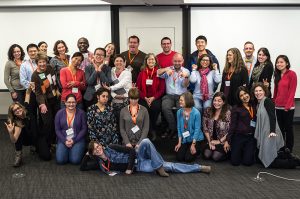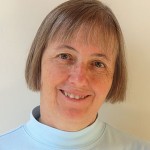Presidential Transitions
This is my last President’s Corner, and I am happy to be turning things over to our 112th president, Barry Nussbaum, who I am sure will provide many entertaining and thought-provoking words of wisdom in these columns. As we all know, there is another, even more consequential presidential transition happening in the next few months as well, and therefore this column addresses two relatively unrelated themes—one relevant to each of these two presidential transitions.
Let’s Not Let the Data Speak for Themselves
Here is a riddle: What does my personal fitness tracker have to do with the 2016 United States presidential election polls? And what do they both have to do with the future of statistics? The answer is they have both provided erroneous data, and they both serve as examples of why statisticians are needed now—more than ever—to understand, interpret, and explain the integrity of data.
By now, almost everyone has read or heard potential explanations for why many of the polls got the predictions for the U.S. presidential election wrong, including the possibility that the polls would have been right if they had not influenced voting behavior. Clearly, the problem exceeded what would be expected from sampling error, and some potential explanations include using the wrong sampling frame (not enough rural voters), a propensity to lie (Hillary was a more socially acceptable answer), unequal strength of conviction from those supporting the two candidates that was not accounted for (Trump supporters more likely to vote, especially in areas with long waiting times), and so on. I’m sure there will be more analyses in the coming months, and there may still be some surprises as final vote tallies come in. (They are not all finalized as I am writing this.) But in the months leading up to the election, several statisticians shared their concerns with me that the polls suffered from these problems and were likely to be wrong, based on the larger context of what they were seeing.
What about the fitness tracker? A few days ago, I was in Vietnam and took a four-hour bus ride from Ha Long Bay to Hanoi. When I arrived, my fitness tracker had given me credit for taking 9,124 steps and climbing 81 flights of stairs during those four hours, even though I only left my seat once during a short rest stop. Like elsewhere, the roads in Vietnam could use some improvements, and the continuous bouncing mimicked the cadence of walking and climbing stairs. In the opposite extreme, I once walked the full length of the Atlanta airport with my hand on my four-wheeled suitcase and got no credit for any steps. I’ve noticed a similar lack of credit when wheeling a grocery cart, and pushing a baby stroller allegedly has the same effect. Because I was there to watch these data errors occur, I knew the data were unreliable in those situations.
When I told this story to a nonstatistician friend, I thought it was just a quirky story with no real consequences. But she explained that such is not the case. The health plan where she works sets rates based on data acquired from employees’ personal fitness devices! So in that case, the integrity of the data from the device has important financial consequences to the wearer. And it is unlikely that the insurance company is going to be able to differentiate between the user running a marathon and taking a long and slow bus ride on a bumpy road. Auto insurance rates, too, are sometimes tied to driver behavior and distances traveled. Are there ways those data collection efforts can be fooled, as well?
We often hear there has never been a more exciting time to be a statistician. Jobs are plentiful, pay is good, and U.S. News and World Report has ranked statistician as the #1 best business job, based on a combination of factors.
However, I also believe this is a time when it is more important than ever for statisticians to take responsibility for thinking and talking about the quality and integrity of data. We may not always recognize erroneous data, but we are in a better position than most to do so and we know how to design studies to collect useful data. We also need to help ensure that important decisions are based on data, rather than on opinions and politics. That means statisticians need to be proactive in helping people understand the role of data and statistics, and we need to speak out about abuses.
To that end, my presidential initiatives were geared to provide resources for statisticians to reach out, particularly to students and the media. The working group charged with creating materials for statisticians to talk with high-school students about statistics careers has done a wonderful job of providing resources. I want to highlight those resources here, because they are also useful for statisticians to become more broadly aware of what others in our profession do.
There are some great videos and other resources listed under “Tips and Tricks” and “What do statisticians and data scientists do?” that will help us all become better acquainted with what others of us do. And once you feel comfortable talking about our profession, even more broadly than your own job, I encourage you to talk with lots of people about the benefits we provide. You can visit a high-school classroom or simply find opportunities to highlight the important work we do with your family, friends, and social media connections.
Words of Gratitude for My Presidential Year
It is traditional for ASA presidents to use the December President’s Corner to thank those who have participated in making the year a success, and I am delighted to have the opportunity to do that. My warm thanks go to all the ASA staff members who work tirelessly to promote our profession and to keep the ASA vibrant and relevant. I particularly want to thank ASA Executive Director Ron Wasserstein, who seems to know everything that goes on in every corner of the ASA and the statistics world in general and who generously shares his expertise and advice.
Next, I would like to thank all those who invited me to participate in chapter visits and give conference presentations. I loved meeting so many of our members who are active in chapter work and enjoyed visiting the Nevada, Oregon, Pittsburgh, Milwaukee, Montana, and Boston chapters. I’m looking forward to a few more chapter visits scheduled for the coming year.
I enjoyed interacting with students at Smith, Amherst, and Mount Holyoke Colleges, as well as at the Career Day held by the Orange County/Long Beach ASA Chapter and iiData Conference held by the University of California, Davis Student Statistics Club. Talking with students about careers in statistics is one of my favorite activities!
Conference invitations took me on international trips to India and Bangladesh, with upcoming visits to China, Spain, and Sri Lanka, as well as to the Conference on Statistical Practice and Fall Technical Conference. I gained so much from interacting with statisticians at those venues and listening to many other interesting and informative talks. I am extremely grateful to everyone who was involved with providing those opportunities for me to visit and who made me feel welcome when I visited.
The ASA Board members I have worked with have been wonderfully supportive, and I thank them all. Another amazing source of support has been the community of past ASA presidents, many of whom have written to me and spoken with me, providing information, advice, and encouragement. I hope I can pay it forward with advice and encouragement for future presidents.
In my presidential address, I listed names of the members of the working groups appointed to implement my presidential initiatives, and I would like to again thank them for their work. The board members and staff who led these initiative working groups—Anna Nevius, Rob Santos, Wendy Lou, and Donna LaLonde—deserve special thanks. Donna was an active participant in all the initiatives and deserves a special thank you for her work.
Work on all the initiatives is continuing, but there is much to report on their success already. As mentioned earlier, the Careers in Statistics Working Group developed a useful website, that provides resources for ASA members who are willing to talk with high-school (or younger) students about the importance of statistics, including possible careers. The group also encourages ASA members to think about providing internships for high-school students. More about their activities can be found in the October issue of Amstat News, including a link to register for a speakers bureau that will match professional statisticians with teachers who are looking for a speaker.

Participants of the inaugural Media Training Workshop for all ASA members held at ASA headquarters November 15–16
Photo by Rob Santos
Two of my initiatives involve training statisticians to work more closely with the media. The Statistical Ambassadors initiative kicked off with a workshop at JSM, described in the September issue and the Media Training Workshop for all ASA members took place November 15–16 at ASA headquarters.
The training was conducted by ASA partner Sense About Science and included about 25 trainees from across the USA, plus two participants from Canada. The participants received firsthand feedback from mainstream science journalists about how statisticians can help media make their stories better. Trainees also were able to develop and practice their own ‘elevator pitches’ about statistics. It was fun, inspiring, and insightful. And like the Statistical Ambassador training at JSM, participants left the training feeling like better statisticians.
Plans are underway to make more of these opportunities available for ASA members; look for details in Amstat News and through the ASA Community. And please let us know if you would be interested in sponsoring or participating in such a training.
I have saved my final words of gratitude for the largest group to thank, and that’s the thousands of volunteers who are serving and have served on ASA committees and participated in chapter, section, editorial, and meeting activities. Many people have commented to me that the statistics community is such a welcoming and friendly one compared to other academic communities. I couldn’t agree more. Without the help and support of so many of you, the ASA could never provide the rich array of services it provides. I will be forever grateful to have had the opportunity to serve as president of such an enriching organization.



















Thank you Jessica. A very nice article to end the year.